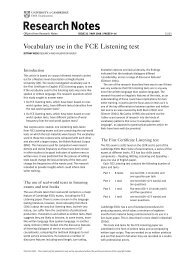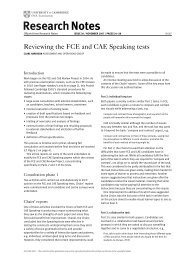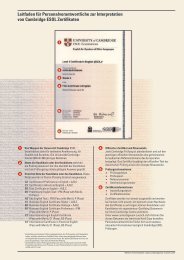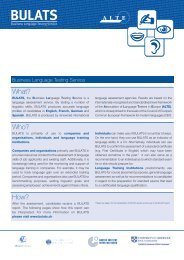ResearchNotes - Cambridge English Exams
ResearchNotes - Cambridge English Exams
ResearchNotes - Cambridge English Exams
Create successful ePaper yourself
Turn your PDF publications into a flip-book with our unique Google optimized e-Paper software.
students), Italy, Switzerland and the United Arab Emirates. Themain aim of this phase of trialling was to establish equivalencebetween PB PET and CB PET, though this was also anotheropportunity to road-test task and navigation design andfunctionality. Candidates participating in trialling also took a paperbasedanchor test, and were scheduled to enter for the paper-basedMarch PET session. Analysis of results found a predicted level ofscore gain from the CB test to the PB test, taken 6–8 weeks later.Earlier studies in CB/PB equivalence (Jones 2000, Green andMaycock 2004, Blackhurst 2005) found no significant difference toscores gained on different formats of BULATS and IELTS tests, andit is anticipated that this pattern will be reflected for CB PET.Equivalence trialling also gave a further opportunity to test therobustness of the online delivery engine and to get additionalcandidate reaction to task design and navigation usability. Allcandidates completed a questionnaire and a number of candidateswere asked to participate in post-test focus groups. The vastmajority of candidates rated the test navigation easy to use, with96% giving ratings of 3 or above on a scale of 1 to 5, where 5indicates total agreement. A number of specific questions relatingto candidates’ reactions to reading, writing and listening oncomputer were asked in order to gauge the general suitability oftaking a test on computer as opposed to on paper. In response tothe question ‘Did you find reading on computer easier thanreading on paper?’ 46% found it easier, whereas only 25%preferred reading on paper. This perhaps reflects an increasingfamiliarity with on-screen reading, at home, in school or at work.Typing written answers on computer was significantly morepopular than writing by hand, with 67% showing a preference fortyping and only 25% expressing a preference for handwriting.Listening was even more popular on computer, with 87%expressing a preference for listening individually on computer tolistening as a group from a CD or cassette player. This is probablynot surprising, as listening through headphones, with the ability toadjust the volume to your desired level, is a more personalexperience. The response method chosen in Listening Part 3,where candidates have to type in a one or two-word answer, wasof particular interest. Candidates were given the option of typing asthey listened, or listening and making notes on paper, then typingin their answer. Two minutes were allowed at the end of the partfor this. Responses were fairly evenly matched, with 42% claimingto have typed as they listened and 53% saying that they madenotes then typed in their answers.Overall, a preference for taking PET on computer was expressedby the majority of candidates. 63% preferred taking the Readingand Writing test on computer, as opposed to 20% preferring thepaper-based version. For the Listening test, 83% expressed apreference for the computer version, with only 4% preferring thepaper test. These results were backed up by comments made bycandidates in the focus groups. Whilst there was generalsatisfaction with the screen layout and navigation toolbars, a fewcandidates expressed a desire to be able to use a highlighting toolin the reading section, mirroring the function of underlining text onpaper. The technology required to enable this function is currentlybeing investigated for a future release of the software. Somecandidates also expressed a desire to be able to control the start ofeach part of the Listening test. However, whilst it would bepossible to cut up the sound files by part, this would removeequivalence of format with the paper-based test. In addition tomeasuring any impact on task difficulty, problems would arise oversetting a maximum time for the length of pause between differentparts and for the test itself.ConclusionEarly indications are that CB PET appears to be well suited to asizeable proportion of the PET candidature and it is anticipatedthat it will become increasingly popular with centres looking forgreater flexibility and faster turnaround times. However, it isappreciated that not all centres are equipped to deliver computerbasedproducts and some candidates will still prefer to take thepaper-based version, so CB PET has been developed as anadditional service rather than a replacement for traditional PB PETsessions. CB PET is being launched with a small number ofEuropean based centres in November 2005, prior to a widerword-wide rollout from March 2006.ReferencesBlackhurst, A (2005) Listening, Reading and Writing on computer-basedand paper-based versions of IELTS, Research Notes 21, 14–17.Green, A and Maycock, L (2004) Computer-based IELTS and paper-basedIELTS, Research Notes 18, 3–6.Jones, N (2000) BULATS: A case study comparing computer-based andpaper-and-pencil tests, Research Notes 3, 10–13.This is an extract from Research Notes, published quarterly by University of <strong>Cambridge</strong> ESOL Examinations.Previous issues are available on-line from www.<strong>Cambridge</strong>ESOL.org© UCLES 2005 – this article may not be reproduced without the written permission of the copyright holder.RESEARCH NOTES : ISSUE 22 / NOVEMBER 2005 / PAGES 9–13 | 4









